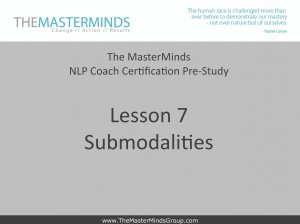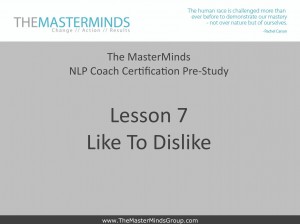Welcome to Lesson 7 on Submodalities.
What’s common to all these questions?
- How to acquire control over your emotions?
- How to see the glass half full rather than half empty?
- How to get to stop eating a food you love that’s bad for you?
- How to change the disempowering beliefs you have about yourself?
SUBMODALITIES.
What are they? A really easy (when I say easy, I mean EASY) way to achieve all of the above.
Sounds good?
Click on the links below:
Accessing States At The Click of a Finger (this is an audio file, click on the little triangle below to listen)
[audio: http://the.masterminds.nlp.tutorials.com.s3.amazonaws.com/Lesson7/Lesson_7_Accessing_states.mov]Submodalities explained, what REALLY makes them work.

Submodalities checklist (in pdf format, needed for the next video)
Script: How to do a “Like To Dislike” change session (to make someone dislike a food they love but they want to stop eating for example).

A question that is often asked: ‘What is the difference between the visual submodalities ‘Framed and Panoramic’? Can you give an example?
Click on the link to open a pdf with a visual example: Submodalities Explained
Powerful stuff hey?
We’ll do lots of exercises with Submodalities during the training, you can start using them yourself to change the pictures, sounds or feelings you have inside.
And as usual, post your questions below.
Hi – just a tiny query about the submodalities. I don’t understand what “Framed or Panoramic” means. Could you give an example?
Thank you.
Marina
Marina, I have posted a pdf with a visual example. See the link ‘Submodalities Explained’ in the lesson above.
Hi Marina,
Imagine a picture in your mind. ‘Framed’ means that the picture is limited by a frame, so you would see the picture framed against a larger background. ‘Panoramic’ means that it takes the whole space, there is no background outside of the picture.
Does that answer your questions? If not, let me know, I’ll post examples in the lesson.
Gottit – thank you!
Hi Sil,
Generally, I would say that we judge our result based on behaviour. If the person gets the result, then it does not really matter whether they have synesthesia or not. It is extremely rare that a person can absolutely not have a picture in their mind (almost never happens), most of the time, they THINK they can’t, but if it happens to be the case then we can work with other submodalities. Since you seems to know that you have synesthesia (is it V/K?), we can experiment with you during the live training.